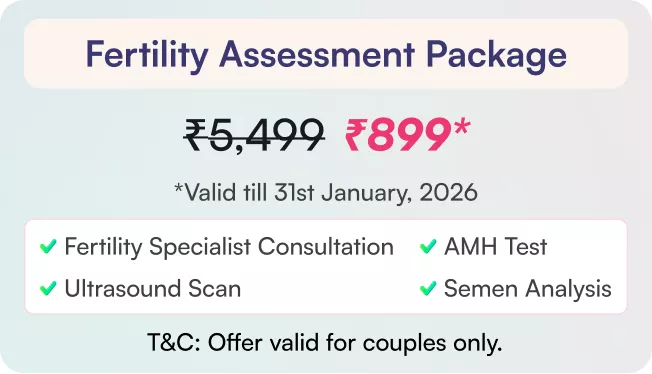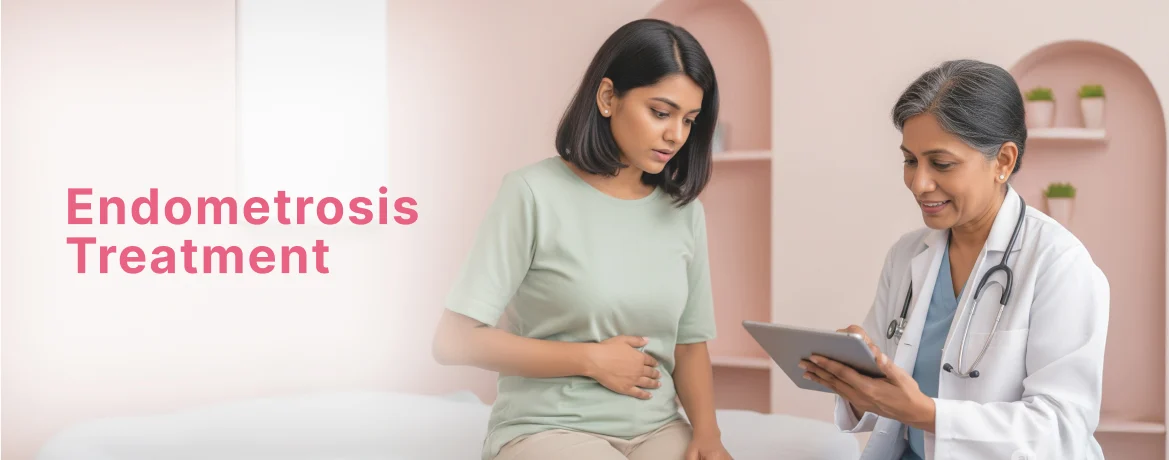For millions of women in India, severe period pain is often dismissed as a normal part of life. However, debilitating pain can be a sign of Endometriosis, a common yet frequently misunderstood medical condition. Endometriosis not only affects a woman’s quality of life but is also a leading cause of infertility.
This page provides a clear and comprehensive overview to help you understand this condition better. Let us discuss everything from the fundamental questions—what endometriosis is, its types, and its causes—to recognizing its symptoms and risk factors. Furthermore, we will discuss how endometriosis is diagnosed and explore the different treatment options available to manage the condition and support your health goals.
What is Endometriosis?
Imagine the tissue that normally lines the inside of your uterus (the endometrium) begins to grow in places where it shouldn’t, such as on your ovaries, fallopian tubes, or the lining of your pelvis. This is endometriosis.Each month, this misplaced tissue behaves just like the lining of your uterus—it thickens, breaks down, and bleeds during your menstrual cycle. However, because this blood has no way to exit the body, it gets trapped. This leads to inflammation, severe pain, and the formation of scar tissue (adhesions), which can interfere with fertility.
What are the Types of Endometriosis?
Endometriosis is generally categorized based on where the misplaced tissue is located:
- Superficial Endometriosis: The most common form, where small patches or lesions of endometrial tissue appear on the surface of your pelvic organs.
- Ovarian Endometriomas (“Chocolate Cysts”): These are cysts filled with dark, old blood that form inside the ovaries. They are called “chocolate cysts” because of their appearance and can directly impact egg quality and quantity.
- Deeply Infiltrating Endometriosis: A more severe form where the tissue grows deep into the walls of the pelvic organs, such as the bladder, bowels, or rectum, often causing significant pain.
What are the Causes of Endometriosis?
While the exact cause is not known for certain, the most widely accepted theory is:
- Retrograde Menstruation (The “Backflow” Theory): This suggests that during menstruation, some menstrual blood containing endometrial cells flows backward through the fallopian tubes and into the pelvic cavity, where the cells implant and grow. Genetics also plays a significant role; if your mother or sister has endometriosis, you have a higher risk.
Risk Factors Associated with Endometriosis
You may be at a higher risk for endometriosis if you:
- Have a close family member (mother, aunt, sister) with the condition.
- Started your period at an early age.
- Have never given birth.
- Experience short menstrual cycles (less than 27 days) or heavy periods that last longer than seven days.
What are the Symptoms of Endometriosis?
Symptoms can vary greatly from person to person. Some women have severe symptoms, while others have none. The most common signs include:
- Extremely Painful Periods: Pain that is far worse than normal menstrual cramps.
- Pain During or After Intercourse.
- Pain with Bowel Movements or Urination, especially during your period.
- Heavy Bleeding during periods or bleeding between periods.
- Infertility: For some women, the inability to get pregnant is the only sign they have endometriosis.
- Fatigue, diarrhea, constipation, and bloating, particularly during menstrual periods.
How is Endometriosis Diagnosed?
A correct diagnosis is the first step toward effective treatment. At Ferty9, we use a systematic approach:
- Medical History and Pelvic Exam: Your doctor will discuss your symptoms and may perform a physical exam to feel for any cysts or scar tissue.
- Ultrasound (Transvaginal Scan): This imaging test uses sound waves to create pictures of your reproductive organs and is very effective at identifying ovarian cysts (“chocolate cysts”).
- Laparoscopy: This is the “gold standard” for diagnosis. It is a minimally invasive keyhole surgery where a doctor inserts a thin, lighted camera (laparoscope) into your abdomen to directly see the endometrial growths. Often, the doctor can remove the growths during the same procedure.
How is Endometriosis Treated?
Treatment depends on your symptoms, the severity of the condition, and your family planning goals.
- For Pain Management: If you are not trying to get pregnant, hormonal medications or birth control pills can be prescribed to manage pain and stop the growths from getting worse.
- For Improving Fertility:
- Laparoscopic Surgery: This is often the first line of treatment for women wanting to conceive. By surgically removing the endometrial cysts, patches, and scar tissue, we can restore the normal anatomy of the pelvis and improve the chances of natural pregnancy.
- Assisted Reproductive Technology (ART): If natural conception is still difficult after surgery, or if surgery is not the best option, treatments like IUI and IVF can help you bypass the challenges caused by endometriosis. IVF is particularly effective as it involves fertilizing the egg outside the body.
Why Choose Ferty9 for Endometriosis Treatment?
Choosing the right centre is crucial when dealing with a condition that impacts both your health and fertility.
- Dual Expertise: We are fertility specialists first. Our approach to treating endometriosis always prioritizes the preservation and enhancement of your future fertility.
- Advanced Laparoscopic Surgeons: Our team consists of highly skilled surgeons who excel at minimally invasive techniques, ensuring effective removal of endometriosis with faster recovery times.
- Comprehensive Care Under One Roof: From diagnosis and surgery to advanced fertility treatments like IVF, Ferty9 provides a complete and seamless care path.
- Personalized Treatment Plans: We understand that every patient is unique. We create a tailored treatment plan based on your specific condition, symptoms, and desire to have a family.
FAQ's








